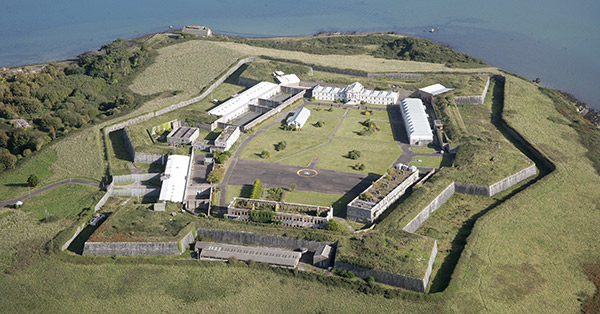Locked up for being poor
Published in 18th-19th Century Social Perspectives, Issue 6 (November/December 2018), News, Volume 26Victorian and modern prison regimes on Spike Island, Co. Cork.
By Barra Ó Donnabháin
Spike Island is dominated by a Napoleonic-era fortress that was used as a prison from 1847 to 1883, and again from 1985 to 2004. The Spike Island Archaeological Project was established in 2012 to examine the material remains of the Victorian Convict Depot, which was part of the London government’s response to the Great Famine and took the surplus of male felons from the county and city gaols across the entire island of Ireland. By 1847 those gaols were grossly overcrowded, mostly with people convicted of petty theft. The government took the perspective of not wasting a good crisis and used the labour of the increased number of convicts to complete the fortifications on the island that had been left unfinished after the Battle of Waterloo. The prison held over 2,500 men by 1850 and the death rate was calamitously high until the mid-1850s.
The excavations examined the physical infrastructure of the Victorian prison, including the foundations of long-vanished stockades used to secure soldiers’ barracks converted to prison accommodation, known as the ‘Timber Prison’, a prefabricated building made in London and intended for the Bermuda convict station but diverted to Spike Island in 1848, and the sub-floor deposits in the former barracks building, as well as in the only custom-built prison building on the island, the Punishment Block, opened in 1860. Excavations were also undertaken in the convict graveyard, uncovering a sample of burials that are yielding information about the dire impact of the institution on the physical well-being of the Victorian prisoners.
Spike Island played a critical role in the development of what was known as the ‘Irish System’ after reforms to the Irish convict service in 1854. Spearheaded by an adept self-promoter, Walter Crofton, the Irish System was lauded at the first international penitentiary congresses in the 1870s and influenced penal systems in other jurisdictions. The modern open prison and parole systems owe a lot to Crofton’s Irish System. Other, more sinister continuities are also apparent. In the Victorian prison, social class was the principal determinant of who was incarcerated. Registers of convicts admitted to Spike Island in the 1840s show that the vast majority were unskilled labourers. Furthermore, a racialised conceptualisation of the Irish convict is a recurring theme in the Victorian documents, with, for example, the high death rate blamed on the propensity of the Irish to develop tuberculosis (Irish people are not particularly susceptible to TB but people kept in overcrowded, insanitary conditions are), while one colonial official wrote that it was pointless trying to educate a people who were only suited to general labouring.
While there is no doubt that the modern prison system was much more humane and less injurious to a prisoner’s health, the theme of class and race resurfaced in the analysis of the material remains of the 21st-century institution. The graffiti left in the prison that closed in 2004 usually noted the prisoner’s name, sentence and where they were from, and the same locations crop up again and again—urban areas whose names are bywords for social disadvantage. In the prison library it was clear that a lot of material was aimed at those with poor literacy skills and also that some reading matter was aimed directly at Travellers. A conference held in Dublin in October 2017 heard that while Travellers make up 0.6% of the population of the Republic, they account for 10% of our adult male prison population and a shocking 22% of the adult female prison population (Irish Times, 20 October 2017).

Above: Aerial view of Spike Island. (Con Brogan/National Monuments Service)
Spike Island is now a heritage tourism destination; 21st-century visitors can take daytime as well as night-time tours during which they will be titillated by past brutality and horrified at the class inequality and racism that lay at the heart of the Victorian prison system. Places like Spike Island, however, also raise uncomfortable questions about who is sent to prison in our own society and why. The class and ethnic profiles of prisoners suggest that social exclusion and discrimination—or snobbery and racism—are still principal factors in determining who is incarcerated in Ireland today. We are rightly horrified at what happened in the Magdelene laundries and mother-and-baby homes in the mid-twentieth century and recognise that those injustices occurred because Irish society chose to look away. With our current prison system, are we doing the same today?
Barra Ó Donnabháin, Department of Archaeology, University College Cork.
















